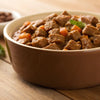Can I Feed My Dog Wet and Dry Food Together? Understanding the Benefits and Best Practices
- Houndsy
Table of Contents
- Introduction
- The Benefits of Dry Dog Food
- The Benefits of Wet Dog Food
- The Reasons to Mix Wet and Dry Dog Food
- How to Mix Wet and Dry Dog Food Properly
- Potential Drawbacks and Considerations
- The Role of the Houndsy Kibble Dispenser
- Conclusion
Introduction
Have you ever faced a mealtime showdown with your dog, who seems to turn their nose up at all options? You're not alone. According to a survey, approximately 40% of dog owners report that their pets can be picky eaters. As devoted pet parents, we all want to ensure our furry companions receive the perfect balance of nutrition, taste, and hydration. This prompts an essential question many of us have: Can I feed my dog wet and dry food together?
Feeding our dogs can be both a delightful and challenging experience. Wet food and dry food each hold distinct advantages, and mixing them can create a unique, appealing meal that meets your dog’s nutritional needs while tantalizing their taste buds. In this blog post, we'll explore the benefits of combining wet and dry dog food, how to do it right, and the potential drawbacks you might encounter along the way.
We invite you to reflect on your own dog’s feeding habits as we guide you through this topic. By the end, we aim to help you decide if incorporating a mix of both food types would enhance your dog's dining experience. Let’s dig in!
The Benefits of Dry Dog Food
To understand the potential advantages of mixing wet and dry food, we first need to consider what each type brings to the table—starting with dry dog food.
Nutritional Stability and Cost-Effectiveness
Dry dog food, or kibble, typically contains less than 12% moisture, which helps with long-term storage and shelf life compared to wet options. Because it is generally less expensive, dry food can stretch your budget further while providing essential nutrients. Many dry kibble brands also include added vitamins and minerals crucial for your dog’s holistic health.
Dental Health
One lesser-known benefit of dry dog food is its potential impact on dental health. When dogs chew on kibble, it can help scrape off plaque and tartar from their teeth, contributing to better oral hygiene. While we won't claim that kibble can replace regular dental care, it certainly can complement your pet's routine.
Convenience
Another reason many dog owners prefer dry food is its convenience. Kibble is easy to store, measure, and serve without the need for refrigeration. As pet parenting can often be busy, this time-saving aspect is a significant plus.
The Benefits of Wet Dog Food
Transitioning to wet dog food, often packaged in cans or pouches, we find a different set of benefits that cater to your dog's dietary needs.
Palatability and Hydration
The primary draw of wet food is how appealing it can be for dogs. Rich in flavors and aromas, it can entice even the fussiest eaters to dig into their bowl. Additionally, because wet dog food generally contains between 75% to 78% moisture, it can help with hydration—especially beneficial for dogs who may not drink enough water on their own.
Nutritional Density
Wet food often features higher quality ingredients, resembling human-grade food more so than dry kibble. This can be particularly appealing for pet parents who want to ensure their dog is consuming wholesome nutrition. It usually contains protein-rich ingredients like real meat, which can be a game-changer for picky or older dogs with diminished senses.
Digestibility
For dogs with dental issues or those recovering from surgery, wet food presents an easier-to-chew option that is gentle on their mouths. Moreover, the texture can aid in digestion, making it an excellent choice for dogs experiencing gastrointestinal sensitivities.
The Reasons to Mix Wet and Dry Dog Food
Now that we've explored the individual benefits of wet and dry foods, let’s delve into why mixing them can enhance your dog’s dining experience.
Tantalizing Variety
Variety is a key factor in improving meal appeal. Just like us, dogs can benefit from a diverse diet. Introducing a mix of wet and dry food can make mealtime exciting, preventing your dog from growing bored with repetitive meals.
Cost-Effectiveness
Combining wet and dry food can also be a liquid-saver for your wallet. Adding wet food as a flavor booster allows you to use less dry kibble while still making mealtime enticing. This strategy not only economizes your ingredients but also ensures your pet receives the flavorful allure of wet food without completely relying on pricier options.
Enhanced Nutritional Profile
A mixed feeding approach allows you to harness the overall benefits of both food types, creating a balanced diet that fulfills your dog’s nutritional needs. The combination can address hydration while still giving your dog the necessary fiber, protein, and other vital nutrients.
Health Benefits
For some dogs, the high moisture content in wet food can be particularly beneficial. This is true for dogs with specific health concerns, such as kidney disease or urinary tract issues, where moisture intake is crucial. A mixture of both food types can promote increased water consumption while providing essential calories.
How to Mix Wet and Dry Dog Food Properly
If you're convinced that mixing wet and dry food is suitable for your dog, it’s essential to understand how to do it properly. Here are some tried-and-true methods for an effortless transition:
Consider Your Dog's Needs
Before diving into any new feeding routine, we recommend consulting your veterinarian. They can provide a personalized guideline based on your dog’s age, weight, activity level, and any healthcare requirements.
Establishing Ratios
When figuring out how much of each food to serve, a commonly recommended ratio starts with 75% dry food to 25% wet food. This ratio can be adjusted over time based on your dog’s preferences and nutritional needs. For older dogs or those undergoing weight management, adaptations may be required.
Introducing New Meals Gradually
If your dog is unfamiliar with mixed meals, introduce the combination gradually. Begin by mixing a small amount of wet food into their usual dry food over the course of a week. This method helps to avoid any potential digestive upset. Dogs often appreciate this new flavor while developing a tolerance for the mix.
Monitor Your Dog’s Reaction
Observe your dog's response closely. If they seem to enjoy the new meals and show signs of increased appetite, you’ve successfully enticed their taste buds! However, if any adverse reactions appear, such as vomiting or diarrhea, reassess the proportions and consult your veterinarian if necessary.
Timing and Storage
The mixed food should not sit out for too long, as bacteria can grow quickly in opened wet food. Ideally, any uneaten mixture should be consumed within 20 to 30 minutes of serving. Proper storage is essential: leftover wet food should be refrigerated and used within a few days of opening.
Potential Drawbacks and Considerations
While mixing wet and dry food can be immensely beneficial, there are a few drawbacks of which you should be mindful:
Higher Costs
Including wet food in your dog’s diet generally incurs higher costs than relying exclusively on dry kibble. This factor may lead you to carefully calculate how much wet food you're adding to maintain your budget.
Spoilage and Waste
Wet food has a much shorter shelf life once opened. If not consumed in a timely manner, it can spoil, leading to waste. Consider your dog’s eating habits and make adjustments accordingly to avoid waste.
Digestive Upset
A sudden introduction of new food can lead to digestive issues in sensitive dogs. Gradual incorporation of mixed meals is essential, but always be alert to any changes in your dog’s stool or overall health following the dietary shift.
The Role of the Houndsy Kibble Dispenser
To enhance your dog feeding experience, consider investing in the Houndsy Kibble Dispenser. Crafted with both design and functionality in mind, this dispenser allows you to deliver perfect portions of kibble effortlessly.
With its large storage capacity of 25–30 lbs, our innovative dispenser is designed to keep your dog's dry food fresh. The BPA-free liner ensures that every kibble remains delicious and safe for your pet. Plus, with its auto-locking mechanism, you can trust that curious paws won’t accidentally initiate a food escapade!
By using the Houndsy Kibble Dispenser, you can simplify your pet feeding routine while ensuring a consistent diet. Discover the seamless blend of convenience and style by exploring our Houndsy Kibble Dispenser.
Conclusion
In summary, blending wet and dry dog food can open a world of possibilities for both you and your dog. The advantages—ranging from enhanced taste and hydration to supporting overall nutritional needs—make it a worthwhile consideration for many pet parents.
Yet, every dog is unique. It’s essential to factor in your pet’s specific requirements, likes, and any medical considerations before adjusting their diet. If done correctly, mixing can elevate the mealtime experience, making it enjoyable and health-centered.
As you venture into this mixed feeding approach, we encourage you to embrace creativity and flexibility in your pet's diet. Whether it’s incorporating a little wet food for moisture or switching up flavors with the seasons, the goal is to ensure your dog continues to thrive and enjoy a diverse, balanced diet.
To continue exploring how Houndsy can support you in creating the best feeding experience for your dog, remember to check out our Houndsy Kibble Dispenser.
FAQ
Can all dogs eat a mixture of wet and dry food?
Yes, most dogs can benefit from a mixture of both, but those with specific dietary needs or health conditions should consult with a veterinarian first.
How do I choose the right types of food to mix?
Look for high-quality brands that offer both wet and dry options, ensuring they meet AAFCO standards. Quality matters, so read the ingredient labels and aim for options without artificial additives.
What should I do if my dog refuses to eat the mixed food?
Try gradually adjusting the ratio or experimenting with different brands and flavors. Ensure the food is served fresh and at room temperature to heighten tantalizing aromas.
How much wet food can I safely add to my dog's dry food?
As a general guideline, start with 25% wet food mixed with 75% dry, but tailor this ratio based on your dog's individual needs.
Can mixing wet and dry food cause any health issues?
While most dogs adapt well to mixed diets, it's essential to monitor for any digestive issues, particularly with sensitive stomachs. Transition slowly and observe your dog’s reactions to the changes.












